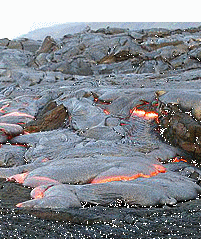

The unevenly spread black lava extended almost to the horizon. It was like a lunar walk except for the blazing tropical sun overhead and heat reflecting off the black surface. And not another living thing in sight.
I was exploring lava flows near Kapa ahu in Hawaii Volcanoes National Park. I had taken the Chain of Craters Road from Park Headquarters and parked my car where it ended abruptly at the beginning of the lava flow. Mine was the only car in the small parking lot and the Ranger Hut was empty.
I had been there a week before with a touring Press group and we had been told that by following red arrows placed on the lava one would find a fissure where the red hot lava could actually be observed. On that visit there had been no time for such an exploratory hike. Now I was back on my own to see such a phenomenon first hand.
Park Rangers suggest, quite wisely, that on such treks one wear long pants, sturdy footwear, carry plenty of water and sunscreen and not go alone.
Except for sturdy shoes I ignored every one of these guidelines. Which was very uncharacteristic of me. Normally I am most cautious in new and unique situations.
Following the red arrows I plodded across the lava fields occasionally crossing some that made a noise like brittle, thin ice beneath ones feet and others where footsteps made an alarming hollow sound. The red arrows came to an end but no sign of any fissure appeared. Still I wandered around in a large circle with no results.
About this time a Couple came into view following the arrows and my path. They were the only people I had seen since leaving Park Headquarters. We talked briefly about where the open fissure might be and then getting hotter, thirstier and aware of possible sun burn I retraced my steps back to my car. Defeated in my quest I followed the Chain of Craters Road back to Volcano House for some much needed refreshments and R and R.
As I was about to leave there I met the couple from the lava fields. They reported that after I left them a Ranger appeared and led them to the fissure with the hot lava bubbling below. They had told the Ranger about me and looked for me but somehow I had missed them. Despite my bitter disappointment on this particular excursion Hawaii Volcanoes National Park is an exciting place and well worth visiting. The Park was so designated in 1916 and since then much territory has been added to protect and preserve the Islands unique ecosystems.
Crater Rim Drive circles the impressive Kilauea caledra which is 400 feet deep and two miles wide. We did this one afternoon as well as looking over the two Park campgrounds. One called Namakani Paio is three miles from the park entrance on Route 11 and the second, conveniently located close to the Chain of Craters Road is called Kulanaokuaiki which includes eating shelters, rest rooms and fireplaces.
Access to the Park is possible from both Hilo and Kailua Kona but it is a 110 mile drive from Kailua Kona. To reach the Park from Kona you should count on a full day since there is much to see en route on Highway 11. From Hilo it is only a 28 mile drive to the Park Visitor Center. One day from Hilo we went to the Park stopping to see the Thurston Lava Tube. A short walk takes one through a lush fern forest to the tube, where a lava flow formed a perfect tunnel. And at the Visitor Center we watched a movie on how volcanoes shape the earth and the world we live in. Another day from Hilo we took Highway 130 past Pahoa and then to Kaimu where lava flow from the East Rift zone brings progress to an abrupt halt on the highway.
Like all National Parks there is much to see and particularly at Hawaii Volcanos Park where the forces that shaped this planet are still at work.
The Big Island Visitors Bureau in Hilo has material of interest including an excellent Park guide. They are on the web at www.bigisland.org. or you can call 1 800 648-2441. The Park website is www.nps.gov/havo.
Editor's Note:Since this Writer's visit, which was a few years ago, Kilauea Volcano has come alive in spectacular fashion and has become a major tourist attraction with the Park Service estimating over 2,500 visitors each day
The new lava flow started on May 12 and has since triggered one major fire which burned more than 3,600 acres of forest. The lava is now easily seen as it crosses the Chain of Craters Road and cascades into the sea. The new lava flow is moving at a rate of more than 300 feet each day.
Graphic Design by Impact Graphics